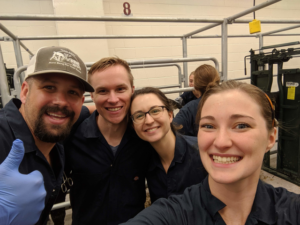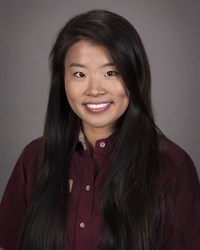In less than six months, I will start my fourth year of veterinary school  here at Texas A&M University!
here at Texas A&M University!
As I look forward to jumping into the last, clinical phase of my education, I am also looking forward to the first experiential phase of my career. Very soon, I will be rotating through different specialized departments in our large and small animal hospitals for a full 12 months, taking on real cases from real clients who bring their cherished pets here for care.
In preparation for this, my classmates and I are making the final decisions about our tracks, or paths, we will complete during those rotations. I plan to choose the mixed animal track and split my time between the large and small animal hospital.
My hope is that this prepares me and gives me confidence to treat any animal that walks into my clinic, no matter if I become a rural mixed animal practitioner or suburban small animal practitioner.
I also must make decisions about which rotations I will participate in—there are exciting opportunities like emergency and critical care, cardiology, orthopedic surgery, equine sports medicine, or even oncology.
I feel I have learned so much during my first three years and am starting to feel competent during case discussions when forming diagnostic and treatment plans, but there is still so much to learn.
As I plan out this final stage of my time here, I worry about fitting in all of the information I need in order to be a competent veterinarian. I worry about my first year after graduation and feeling knowledgeable enough to treat animals while continuing to learn.
Very soon, I will be the doctor in charge of medical decisions, responsible for the life and health of my patients. That’s equally exciting and anxiety-inducing!
Another part of fourth year preparations is arranging a few externship experiences off-site. These externships can take place in private general practice, in a specialty hospital, at another university, or even at different animal refuges, as long as you are working alongside other veterinarians.
One way that the CVM provides opportunities for us to network and  arrange these experiences is through their annual job and externship fair. This weekend, more than 130 practitioners will converge on our school in the hopes of setting up externships with veterinary students and finding new graduates to hire. (https://vetmed.tamu.edu/dvm-job-fair/ )
arrange these experiences is through their annual job and externship fair. This weekend, more than 130 practitioners will converge on our school in the hopes of setting up externships with veterinary students and finding new graduates to hire. (https://vetmed.tamu.edu/dvm-job-fair/ )
It’s quite possible that one of these practitioners or externships will flourish into a job opportunity after graduation!
As I edit my resume and look at all the practices that will be in attendance, I have been thinking about what I’m looking for in a veterinary practice. What kind of team do I want to be part of? What type of mentorship am I looking for? Do I want to do emergencies after hours or live near an emergency hospital I can refer my patients to?
There are so many possibilities that I’m excited to explore!

 graduate.
graduate. Let me tell you, Bozeman is gorgeous. I loved it there. I would wake up in the mornings, and it would be 45 degrees. To put that in perspective, it is the middle of October in Texas, and I don’t think that is has gotten into the 40s yet.
Let me tell you, Bozeman is gorgeous. I loved it there. I would wake up in the mornings, and it would be 45 degrees. To put that in perspective, it is the middle of October in Texas, and I don’t think that is has gotten into the 40s yet. Small and Large Animal Hospitals.
Small and Large Animal Hospitals.


 My experience in veterinary school so far has been an exhilarating, eye-opening, challenging journey. While I’ve had its extreme highs and lows, I can honestly say that I have enjoyed the ride.
My experience in veterinary school so far has been an exhilarating, eye-opening, challenging journey. While I’ve had its extreme highs and lows, I can honestly say that I have enjoyed the ride.
 Wow! This semester has just flown by! It seems like I just started classes again, but, instead, I just completed my finals.
Wow! This semester has just flown by! It seems like I just started classes again, but, instead, I just completed my finals. This upcoming Christmas break will be my last as a student, as my peers and I will be entering clinics immediately after the conclusion of the third-year veterinary curriculum. I have been meticulously planning to get the most out of the four-week break, during which I will be spending two weeks doing a veterinary externship in Dallas and the remaining time traveling with family and friends.
This upcoming Christmas break will be my last as a student, as my peers and I will be entering clinics immediately after the conclusion of the third-year veterinary curriculum. I have been meticulously planning to get the most out of the four-week break, during which I will be spending two weeks doing a veterinary externship in Dallas and the remaining time traveling with family and friends.